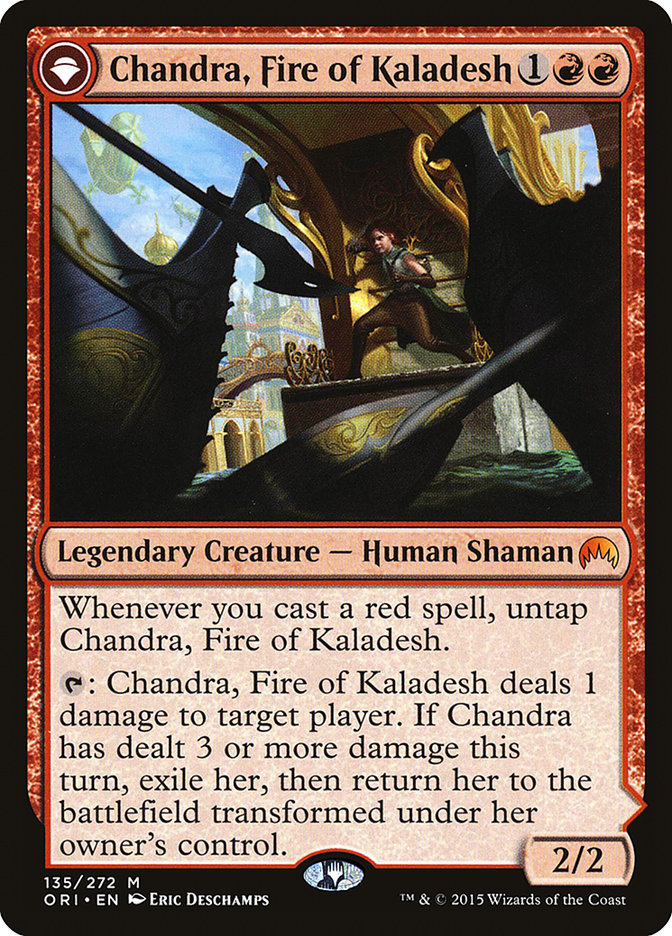

Chandra, Fire of Kaladesh {1}{R}{R}
Legendary Creature — Human Shaman
Whenever you cast a red spell, untap Chandra, Fire of Kaladesh.
{T}: Chandra, Fire of Kaladesh deals 1 damage to target player or planeswalker. If Chandra has dealt 3 or more damage this turn, exile her, then return her to the battlefield transformed under her owner’s control.
Chandra, Roaring Flame
Color Indicator: Red Legendary Planeswalker — Chandra
+1: Chandra, Roaring Flame deals 2 damage to target player or planeswalker.
−2: Chandra, Roaring Flame deals 2 damage to target creature.
−7: Chandra, Roaring Flame deals 6 damage to each opponent. Each player dealt damage this way gets an emblem with “At the beginning of your upkeep, this emblem deals 3 damage to you.”
Illustrated by Eric Deschamps
- Standard
- Not Legal
- Alchemy
- Not Legal
- Pioneer
- Legal
- Explorer
- Not Legal
- Modern
- Legal
- Historic
- Not Legal
- Legacy
- Legal
- Brawl
- Not Legal
- Vintage
- Legal
- Timeless
- Not Legal
- Commander
- Legal
- Pauper
- Not Legal
- Oathbreaker
- Legal
- Penny
- Not Legal
| Faces, Tokens, & Other Parts |
|---|
| Magic Origins Checklist Card, TORI #0 |
| Chandra, Roaring Flame Emblem, TORI #14 |
| Chandra, Fire of Kaladesh // Chandra, Roaring Flame, ORI #135 |
| Prints | USD | EUR | TIX |
|---|---|---|---|
| The List | $2.52 | ||
| From the Vault: Transform | ✶ $3.24 | 0.08 | |
| Magic Origins Promos | ✶ $4.02 | ||
| Magic Origins | $0.95 | €1.78 | 0.02 |
| San Diego Comic-Con 2015 | ✶ $103.88 | ||
| View all prints → | |||
Toolbox
Buy This Card
Notes and Rules Information for Chandra, Fire of Kaladesh // Chandra, Roaring Flame:
- Each player who gets Chandra’s emblem is the owner of that emblem. In multiplayer games, that emblem will remain in the game as long as its owner does, even if Chandra’s owner leaves the game. (2015-06-22)
- The last sentence of Chandra, Fire of Kaladesh’s activated ability isn’t a separate ability. The check happens only as that activated ability resolves. You must activate the ability in order to exile Chandra and return her to the battlefield transformed, even if Chandra has already dealt 3 or more damage during the turn. (2015-06-22)
- Each face of a double-faced card has its own set of characteristics: name, types, subtypes, power and toughness, loyalty, abilities, and so on. While a double-faced card is on the battlefield, consider only the characteristics of the face that’s currently up. The other set of characteristics is ignored. While a double-faced card isn’t on the battlefield, consider only the characteristics of its front face. (2015-06-22)
- The mana value of a double-faced card not on the battlefield is the mana value of its front face. (2015-06-22)
- The back face of a double-faced card (in the case of Magic Origins, the planeswalker face) can’t be cast. (2015-06-22)
- A double-faced card enters the battlefield with its front face up by default, unless a spell or ability instructs you to put it onto the battlefield transformed, in which case it enters with its back face up. (2015-06-22)
- A Magic Origins planeswalker that enters the battlefield because of the ability of its front face will enter with loyalty counters as normal. (2015-06-22)
- In some rare cases, a spell or ability may cause one of these five cards to transform while it’s a creature (front face up) on the battlefield. If this happens, the resulting planeswalker won’t have any loyalty counters on it and will subsequently be put into its owner’s graveyard. (2015-06-22)
- You can activate one of the planeswalker’s loyalty abilities the turn it enters the battlefield. However, you may do so only during one of your main phases when the stack is empty. For example, if the planeswalker enters the battlefield during combat, there will be an opportunity for your opponent to remove it before you can activate one of its abilities. (2015-06-22)
- If a double-faced card is manifested, it will be put onto the battlefield face down (this is also true if it’s put onto the battlefield face down some other way). Note that “face down” is not synonymous with “with its back face up.” A manifested double-faced card is a 2/2 creature with no name, mana cost, creature types, or abilities. While face down, it can’t transform. If the front face of a manifested double-faced card is a creature card, you can turn it face up by paying its mana cost. If you do, its front face will be up. A double-faced card on the battlefield can’t be turned face down. (2015-06-22)
- The emblem created by Chandra, Roaring Flame is colorless. The damage it deals is from a colorless source. (2015-06-22)
- Only players actually dealt damage by the third ability of Chandra, Roaring Flame will get an emblem. If all of that damage to a player is prevented, that player won’t get an emblem. If any of that damage is redirected to Chandra’s controller, that player will get an emblem. (2015-06-22)
- Chandra, Fire of Kaladesh’s activated ability will count any damage Chandra has dealt during the turn to any permanent or player, including combat damage. (2015-06-22)
- The back face of a double-faced card doesn’t have a mana cost. A double-faced permanent with its back face up has a mana value equal to the mana value of its front face. Each back face has a color indicator that defines its color. (2016-04-08)
- For more information on double-faced cards, see the Shadows over Innistrad mechanics article (magic.wizards.com/en/articles/archi…). (2016-07-13)
- You can control two of this permanent, one front-face up and the other back-face up, at the same time. (2017-09-29)